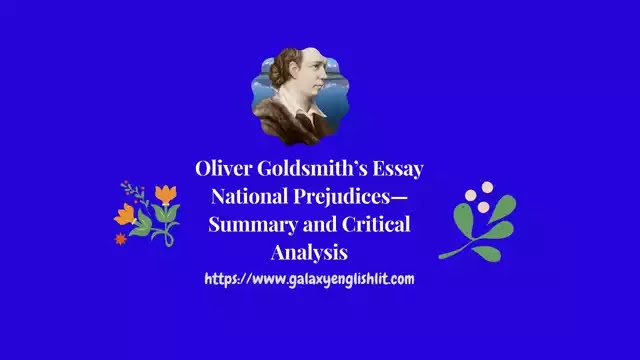Introduction to the Poem:
The poem entitled “Break, Break, Break,” which was first published in the Poems, 1842, is an elegy inspired by the death of Tennyson's dear friend Arthur Hallam in 1833. It is full of deep despair and grief. It reflects the author's heart felt sorrow on the death of his friend. The grief expressed in this brief elegiac poem was later on given a more sustained and philosophical expression in his famous elegy In Memoriam. In the present poem, nature serves to mirror the author's intense feeling of grief.
 |
| Tennyson’s Poem Break, Break, Break—Introduction, Summary, Analysis |
The scene of the poem is Clevedon, church, situated in a homely hill, overlooking the Bristol Channel. Arthur Hallam was buried in this church. The poem was actually composed by the poet walking at night in the lawn near Somersby, though in the poem he imagines himself sitting on Hallam's grave and surveying the scene around.
No poet ever made the dumb so effectually. Observe how the wash of the sea on the cold gray stones is used to prepare the mind for the feeling of helplessness with which the deeper emotions break against the hard and rigid element of human speech; how the picture is then widened out till we see the boy with children laughing on its shore, and the sailor - boy singing on its surface, and the stately ships passing on in the offing to their unseen haven, all with the view of helping us to feel the contrast between the satisfied and the unsatisfied yearnings of the human heart. Tennyson, like every true poet, has the strongest feeling of the spiritual and almost mystic character of the associations attaching to the distant sail which takes the ship on its lonely journey to an invisible port, and has more than once used it to lift the mind into the attitude of hope or trust. But then the song returns again to the helpless breaking of the sea at the foot of crags it cannot climb , not this time to express the inadequacy of human speech to themselves. Thus does Tennyson turn an ordinary sea - shore landscape into a means of finding a voice indescribably sweet for the dumb spirit of human loss.
Summary of the Poem:
To the sad bereaved poet, the waves of the sea breaking on the sea shore appear mourning the death of his friend. It seems to him that the sea is restless and worked - up with sorrow. The sea waves strike their head against the rocky shore and break into water drops . The waves of the sea lash against the rocks but the poet himself remains helpless in conveying his grief.
Human life goes on as usual. The fisherman's boy and the sailor's lad are full of joy. Ships come into the harbour and go out of it as usual. Every business of nature and life is running its normal course, but it will not lessen the poet's grief. His dear friend Hallam will never come back to him. He will never be able to relive the joyful day which he passed in the company of his dear friend.
Critical Analysis:
Poem “Break, Break, Break” ranks among the most poignant elegiac lyrics in the English language. Simple but elegant, intensely subjective yet disciplined, it strikes Tennyson's most personal and poignant note. The poet expresses more eloquently than in any words the sense of desolation made yet more desolate by contrast with joys it cannot share. Praising this elegiac lyric John Pettigrew writes, “A deep distress hath humanized my soul”, wrote Wordsworth in the Elegiac Stanzas prompted by the sudden death of his brother: Deep distress humanizes Tennyson's too, giving. obviously and immediately, the validity of intense personal experience the eternal note of sadness that had earlier often been artificial, vapid, sentimental: there is nothing ‘painted’ in Break, Break, Break, supremely felt, simple, and disciplined, which will forever stand among the world's great laments. Hallam's death not only nourishes Tennyson's elegiac gifts; it also sharpens the opposing forces within the divided sensibility, his grief simultaneously encouraging retreat into solitary brooding, and demanding a need to advance.”
Break, Break, Break, a miracle of verbal purity and rightness, marks the yearnings and regret never fully to be uttered yet here perfectly suggested by sharp contrast and clear image. Against the measured rhythm of the breakers ring out the call of life - the happy shout of childhood and the confident song of youth; but the very cry of joy serves simply as a reminder of “the sound of a voice that is still”. Likewise, the stately ships, tokens of a resolute maturity, move on toward their haven of fulfilment; yet their motion must recall " the touch of a vanish'd hand” and to evoke the sense of immutably broken purpose. The sea itself, symbol of all sound and movement, encompasses the three ages of man in an endless cycle of energy; but no return in all of time can restore to the individual his lost experience:
Break, break, break,
At the foot of thy crags, O Sea!
But the tender grace of a day that is dead
Will never come back to me.
No other of the 1842 pieces quite attains the bold simplicity of this; no other registers so directly Tennyson's own deep nostalgia, indicates more clearly how his grief without denying itself could achieve beauty through the discipline of art. (J. H. Buckley)





